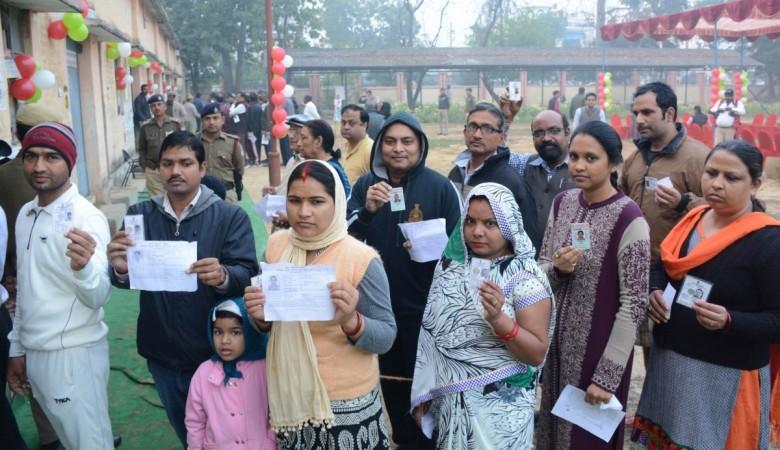
The exit poll predictions are out for the five crucial Assembly elections that took place in February and March and showed that the two national parties – the BJP and Congress – were the frontrunners to grab power in these states.
While all the exit polls predicted the BJP to be the single-largest party in Uttar Pradesh, with two even forecasting it to get a massive majority in the 403-member Assembly, the Congress was predicted to make a comeback in Punjab where it has been out of power for a decade now.
Prime Minister Narendra Modi's party was also predicted to win both Uttarakhand and Goa, while the forecasts were split in Manipur between the two national parties.
One thing was clear from the exit poll surveys: it is mostly the BJP and partially the Congress which is expected to have the last laugh in these polls.
That raises the pertinent question: Are the regional parties losing their magic?
Exit polls have shown both SP and BSP losing ground in UP
If the exit poll predictions prove to be true, the biggest shock (though many observers are not unhappy with the possibility) could come in Uttar Pradesh. The cow-belt state has been ruled by either the Samajwadi Party (SP) or the Bahujan Samaj Party (BSP) for most of the period since 1993 when Mulayam Singh Yadav became the chief minister of the state as a member of the SP for the first time.
Except the five years between 1997 and 2002 when the BJP was in power, it has either been the Yadavs or Mayawati to take the throne in Lucknow. In the past two elections, the BSP and SP even attained majorities by themselves. But this time, the exit polls have shown a sharp decline in both parties' tally, similar to what had happened in the 2014 Lok Sabha election when the traditional four-pronged fight was reduced to a single-party domination. Are the people of the state done with the two regional parties and find Prime Minister Narendra Modi a far better player to rely on?
In Punjab, parties like SAD and AAP are not favourites
In Punjab too, the prediction of the Congress' return conveys the message that the Aam Aadmi Party (AAP) is still not trusted as a worthy alternative. Arvind Kejriwal's theatrics may not have persuaded the local voters and while the BJP is expected to sink in the agricultural belt owing to a strong anti-incumbency against its senior ally Shiromani Akali Dal, the Congress is likely to get a boost, despite its poor state of affairs across the nation.
In Manipur, BJP could see a surge
In Manipur, expecting the BJP to win a minimum of 16 seats and a maximum of 31 is remarkable. It shows that even if the anti-incumbency and other factors could gain momentum against the ruling Congress, the direct beneficiary has been the BJP and not any local outfit, including Irom Sharmila Chanu's People's Resurgence Justice Alliance. The Naga People's Front may have a key role to play if none of the two national parties touches the magic figure of 31 in the 60-member Assembly but still the fact that the BJP and Congress would be wrestling for power in a north-eastern state is something that happens rarely. Nothing was projected about the Trinamool Congress, too, which had seven seats in the Manipur Assembly in 2012 – the second-highest tally after the Congress (42).
Nobody talks about the regional outfits in Goa and Uttarakhand now
In states like Goa and Uttarakhand too, the game is restricted between the BJP and Congress, with the former appearing to be the favourites to add the states to its kitty. The AAP is predicted to finish a poor third after both the national parties while little is being heard about state-specific parties like the Maharashtra Gomantak Party in Goa or the Uttarakhand Kranti Dal.
The Kranti Dal, which had won four seats in 2002, the first time an election was held in the hill state, has only seen its performance diminishing in the subsequent elections. Despite the Congress losing its base at a fast pace, the state's local parties have not been able to make any mark. The BJP, despite its factionalism and a strategic blunder last year to topple the Harish Rawat government, could still won the voters' faith this time.
Signs of stability?
The tendency of the national parties to regain prominence is a positive one (the 2014 election results in Maharashtra, Haryana and Jharkhand also saw the regional parties getting less prominence). After the results that came out in Delhi, Bihar, West Bengal and Tamil Nadu in the last few years, it is a signal of stability (it will see Rajya Sabha becoming a more peaceful place). The regional parties that grew mostly on the ruins of the Congress system have failed to come of age while Narendra Modi has given the BJP a strong leadership. The aam aadmi has perhaps started understanding it and that is getting reflected in their voting behaviour.

















